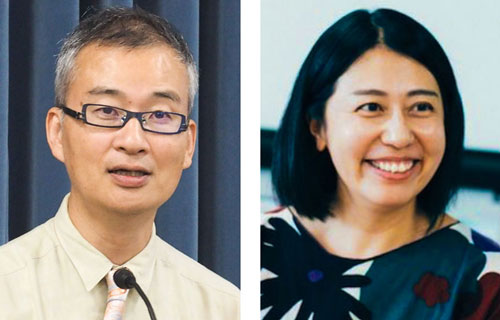Prof. Yoshida and Prof. Ishihara have been selected as the 2019 Nishina Memorial Prize laureates.
On November 7, 2019, the Nishina Memorial Foundation announced that Prof. Shigeru Yoshida (Graduate School of Science) and Prof. Aya Ishihara (Institute for Global Prominent Research) were selected as the recipients of the 2019 Nishina Memorial Prize. The research outcome that they are awarded for is the “discovery of ultra-high energy cosmic neutrinos.”

The Nishina Memorial Prize was established in 1955 to commemorate the achievements of Dr. Yoshio Nishina, who is regarded as the father of modern physics in Japan. Since then, the Nishina Memorial Prize has honored researchers who have achieved outstanding research outcomes in physics. Six of the Japanese Nobel Prize winners have received this award in the past.
Prof. Yoshida and Prof. Ishihara have participated in the IceCube Collaboration, the international group of scientists responsible for the scientific research with the IceCube Neutrino Observatory at Antarctica. They have been among the core members in the Collaboration since its commencement. The mission of the IceCube Observatory is to explore the origin and the mechanism of the universe with detecting neutrinos, which are invisible elementary particles.
The construction of IceCube was completed in 2011. Now, it observes neutrinos coming from space using 5,160 photodetectors embedded in the ice below the South Pole. Prof. Yoshida and Prof. Ishihara established an analysis method that can reliably detect any type of neutrinos if they are at ultra-high energies. By using this method, Prof. Ishihara searched for ultra-high energy cosmic neutrinos with a huge amount of data taken by IceCube observatory at years of 2010-2012. She discovered that there were two events of ultra-high energy neutrinos. They were the first ultra-high energy neutrino events observed by humankind.
In 2012, Prof. Ishihara gave a lecture at the international conference “Neutrino 2012”, and this result was announced publicly for the first time. The paper that she compiled as a corresponding author was published in Physical Review Letters in 2013. It was also chosen an Editors' Suggestion to highlight remarkable papers which draw the broad interests across the various fields of physics[1].
After this achievement, the IceCube Collaboration established a new online data processing flow to send alerts of high energy cosmic neutrino detections to the world-wide astronomers’ community. The real-time identifications of cosmic neutrinos with this system allow astronomical researchers around the world to access the observational information within a few seconds after the neutrino signal detection. It brings a global collaboration between astronomical facilities to support follow-up observations to find the sources of the neutrinos.
In the IceCube Collaboration's efforts toward the neutrino-led multi-messenger astronomy, Prof. Yoshida played a leading role in developing the analysis channel to identify ultra-high energy cosmic neutrinos real-timely. The algorithm of this channel is based on the scheme in the searches for ultra-high energy cosmic neutrinos initially developed by Prof. Ishihara.
The great discovery was made by a neutrino messenger identified by this system on September 23, 2017 (Japan Time). This event, called “IceCube-170922A,” initiated rapid follow-up observations at various wavelengths from radio to gamma rays. They revealed that a blazar galaxy, “TXS 0506+056” with a brighter shine than usual, coincided with the arrival direction of the “ IceCube-170922A” neutrino. Immediately after this neutrino detection, Prof. Yoshida was engaged in one of the key analyses to show that the “IceCube-170922A” appears indeed to originate in this galaxy. Together with all the other analyses conducted in the international team, the blazar “TXS 0506+056” was identified as a celestial body emitting ultrahigh-energy neutrinos for the first time in human history.
The discovery was published in Science in 2018; it was also selected as one of the breakthroughs of the year [2]. These series of research achievements were globally regarded as the beginning of multi-messenger astronomy. The Nishina Memorial Prize is being awarded this year to Prof. Yoshida and Prof. Ishihara to celebrate these achievements.
Prof. Yoshida said, “I thought that I was a researcher who was far from being awarded such a prestigious prize. However, owing to the contributions of many excellent collaborators around the world, we were able to make the exciting discoveries. I could never have reached where I am now without my great colleagues in the team. I would like to share this award with them. ”
Prof. Ishihara said, “I appreciate that the achievements we have made were celebrated by this prestigious award. It is a great encouragement for me to continue my research on neutrino astronomy. I have also heard that this is only the second time that the Nishida Memorial Prize is being given to a female researcher; therefore, I have renewed my desire to do my best to expand diversity in the field of physics. ”
Related Information
Youtube Video
Hadron Astrophysics, a Strategic Research ProgramRelated News
- Nishina Memorial Prize web page
- Science selected the IceCube Neutrino Observation Experiment as one of the 2018 Breakthrough of this year.
Article Information
[1] “First Observation of PeV-Energy Neutrinos with IceCube”, IceCube Collaboration, Phys. Rev. Lett. 111, 021103, (2013).[2] “Multimessenger observations of a flaring blazar coincident with high-energy neutrino IceCube-170922A”, The IceCube collaboration et al., Science 361, eaat1378 (2018).
Contact Information
International Center for Hadron Astrophysics, Graduate School of Science, Chiba University
tel: +81-43-290-2763
e-mail: icehap [a] ml.chiba-u.jp (Please replace [a] with @) /Megumi Takahashi.
